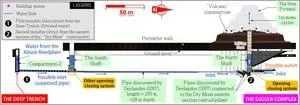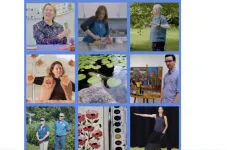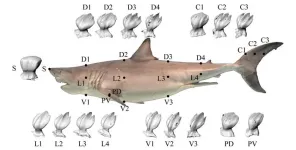(Press-News.org) (MEMPHIS, Tenn. – August 5, 2024) Chimeric antigen receptor (CAR) T–cell immunotherapy re-engineers a patient’s immune cells to target cancer cells. While successful in some types of leukemia, the approach has yet to realize its potential against pediatric solid tumors. Scientists at St. Jude Children’s Research Hospital have identified a way to improve CAR T–cell homing – a T cell’s ability to navigate effectively to a tumor – for osteosarcoma. Improved homing is a necessary step in designing more successful CAR T–cell therapies. The results were published today in Clinical Cancer Research, a journal of the American Association for Cancer Research.
Osteosarcoma is the most common type of bone cancer in children and teens. It typically starts in the wide ends of long bones, such as the legs, but can also occur in other bones, such as the pelvis and skull. Approximately 15-20% of patients with osteosarcoma already have metastatic disease when they are diagnosed, and less than 20% of those with metastatic or relapsed disease survive beyond three years.
Treatment for osteosarcoma includes surgery and chemotherapy – approaches that have been a mainstay of care for over 50 years. This underscores the need for novel, more modern therapeutic approaches such as immunotherapy. However, solid tumors present additional challenges that any CAR T–cell technology must overcome to succeed.
“Solid tumors are just that, solid – these are hard, dense masses which are difficult for immune cells to penetrate,” said first and corresponding author Lindsay Talbot, MD, St. Jude Department of Surgery. “For immunotherapy to work for solid tumors we need to attract T cells to the tumor, help them penetrate it and keep them there to generate a prolonged response.”
Talbot and her colleagues focused on the first step: homing.
Unique chemokines help T cells home to cancer
Imagine a dog that wants to find their favorite bone, lost somewhere in the backyard – they would use their nose to track the scent of the bone to its location. A T cell is like the dog, the bone is like a tumor and the scent the bone emits is like a chemokine. Chemokines are proteins secreted by cells in the body, such as tumor cells, to attract immune cells. Homing happens when the bone’s scent reaches the dog – it will zero in on the bone’s location and go there. However, T cells’ “noses” often cannot pick up the scent of cancer cells, i.e., T cells do not express the receptors, which recognize the chemokines secreted by tumors. T-cell engineering can overcome this chemokine/chemokine receptor mismatch.
There are approximately 50 chemokines and 20 chemokine receptors in humans. To improve CAR T–cell homing to osteosarcoma, the researchers had to first determine which chemokines are expressed by that particular cancer type.
“We used patient specimens gathered after surgery to guide us to which chemokines to target in osteosarcoma, agnostically screening for the ones produced by the tumor—that’s as close to what occurs inside a patient as we can get,” explained Talbot, an active surgeon at St. Jude. “When you combine that with gene expression data, you get very robust results about which chemokines are important for a specific type of cancer.”
Using this approach, the researchers identified two chemokines, CXCL8 and CXCL16, secreted by osteosarcoma. However, CAR T cells do not express the receptors for these chemokines.
A first step toward realizing immunotherapy for osteosarcoma
Having identified this chemokine/chemokine receptor mismatch, the researchers modified CAR T cells targeting the osteosarcoma antigen B7-H3 to express the receptors (CXCR2 or CXCR6) for the identified chemokines. They evaluated the homing kinetics (movement) and efficiency of the modified cells – testing their ability to find and infiltrate osteosarcoma. The researchers found that the engineered cells behaved differently. Those expressing CXCR2 quickly homed and arrived at the tumor but plateaued in their activity early. Those expressing CXCR6 took a little longer to home, but similarly plateaued. Notably, the researchers observed prolonged survival in a model of metastatic disease using the CXCR2 or CXCR6 modified B7-H3-CAR T cells compared to unmodified B7-H3-CAR T cells.
“We haven’t changed anything about how the T cells kill the tumor cells; what we’ve changed is how well they get to the tumor, and that has implications for specificity and toxicity,” said Talbot. “But the work isn’t over, and I’m very excited about the opportunity to continue making strides toward solid tumor immunotherapy with this platform.”
Looking ahead, paper author Christopher DeRenzo, MD, MBA, St. Jude Department of Bone Marrow Transplantation & Cellular Therapy, reflects on the findings’ clinical implications. “Immunotherapy has tremendous potential as a treatment for cancer, but there is still a lot of work to be done to realize that potential in pediatric solid tumors. Improving CAR T cells to better home to osteosarcoma is an exciting advance, so we are working on connecting laboratory discoveries like this with what we can do for patients through clinical trials.”
Stephen Gottschalk, MD, St. Jude Department of Bone Marrow Transplantation & Cellular Therapy chair and an author on the paper, sums up the works’ implications, “By devising a strategy to increase the homing of CAR T cells to osteosarcoma sites, Dr. Talbot and her team were able to demonstrate that these cells have improved anti-tumor activity in preclinical models.” He adds, “Based on these findings, we are committed to translating these ‘improved osteosarcoma finder’ CAR T cells into early phase clinical testing.”
Authors and funding
The study’s other authors are Ashley Chabot, Aaron Ross, Alexandra Beckett, Phuong Nguyen, Andrew Fleming, Peter Chockley, Heather Shepphard and Jian Wang, all of St. Jude
The study was supported by the Rally Foundation (20YIN44 and 21YIC21), the Assissi Foundation of Memphis (94-000R21), the National Cancer Institute Early-Stage Surgeon Scientist Program (3P30CA021765043S1) and ALSAC, the fundraising and awareness organization of St. Jude.
St. Jude Media Relations Contacts
Michael Sheffield
Desk: (901) 595-0221
Michael.sheffield@stjude.org
media@stjude.org
Rae Lyn Hartley
Cell: (901) 686-2597
raelyn.hartley@stjude.org
media@stjude.org
St. Jude Children's Research Hospital
St. Jude Children's Research Hospital is leading the way the world understands, treats and cures childhood cancer, sickle cell disease and other life-threatening disorders. It is the only National Cancer Institute-designated Comprehensive Cancer Center devoted solely to children. Treatments developed at St. Jude have helped push the overall childhood cancer survival rate from 20% to 80% since the hospital opened more than 60 years ago. St. Jude shares the breakthroughs it makes to help doctors and researchers at local hospitals and cancer centers around the world improve the quality of treatment and care for even more children. To learn more, visit stjude.org, read St. Jude Progress, a digital magazine, and follow St. Jude on social media at @stjuderesearch.
END
Improved chemokine homing enhances CAR T–cell therapy for osteosarcoma
Scientists at St. Jude Children’s Research Hospital identified chemokines expressed by osteosarcoma that improved CAR T-cell homing, with implications for immunotherapy development
2024-08-05
ELSE PRESS RELEASES FROM THIS DATE:
Forecasting climate’s impact on a debilitating disease
2024-08-05
In Brazil, climate and other human-made environmental changes threaten decades-long efforts to fight a widespread and debilitating parasitic disease. Now, a partnership between researchers from Stanford and Brazil is helping to proactively predict these impacts.
Schistosomiasis, spread by freshwater snails, affects more than 200 million people in many tropical regions of the world. It can cause stomach pain and irreversible consequences such as enlarged liver and cancer. Public health officials worry that deforestation, rapid urban sprawl, and changing rainfall patterns – such as ...
Deaths from advanced lung cancer have dropped significantly since immunotherapy became standard-of-care
2024-08-05
Since the first immunotherapy drug to boost the body’s immune response against advanced lung cancer was introduced in the United States in 2015, survival rates of patients with the disease have improved significantly. That’s the conclusion of a recent real-world study published by Wiley online in CANCER, a peer-reviewed journal of the American Cancer Society.
For the research, a team led by Dipesh Uprety, MD, FACP, of the Barbara Ann Karmanos Cancer Institute and the Wayne State University School of Medicine, analyzed data from the National Cancer Institute Surveillance, Epidemiology, and End Results database, which compiles cancer-related data ...
Air quality regimes around the world are playing catch up as science evolves and policy ambitions are too blunt, researchers say
2024-08-05
The failure to co-ordinate legal, policy and scientific thinking risks “a squandering of opportunity” to improve air quality, concludes new environmental law research, co-led by a UCL academic.
In their Science paper, ‘Harnessing science, policy and law to deliver clean air’, Professors Eloise Scotford (UCL Faculty of Laws), Alastair Lewis (University of York) and Delphine Misonne (UCLouvain Saint-Louis, Brussels) review recent research and highlight significant risks to achieving clean air globally.
Despite significant achievements in air quality law and policy in some parts of the world ...
Engineers develop general, high-speed technology to model, understand catalytic reactions
2024-08-05
AMES, Iowa – Researchers have been studying the industrial production of ammonia for a century. But they’ve struggled to find ways to improve the low-yield, low-efficiency process.
Atmospheric nitrogen, with the aid of an iron catalyst, reacts with hydrogen to produce ammonia. That reaction produces lots of ammonia – worldwide production is 160 million tons every year. Most is used in agriculture, especially as nitrogen fertilizer. It’s also used in many industries, including refrigeration ...
New $1.9 million PSU grant aims to improve outcomes for students with disabilities
2024-08-05
Improving outcomes for students with disabilities as they transition from high school to postsecondary education and employment starts with effective training and development opportunities for the secondary educators who support them.
Portland State University (PSU) has received a $1.9 million grant to redesign, implement and test a professional development model that aims to provide essential training for secondary educators. The grant, awarded by the U.S. Department of Education’s prestigious Institute of Education Sciences, will fund a four-year project titled "Transition Coalition Self-Study Plus (TCSS+): A ...
In law enforcement, a link between head injuries and depression, PTSD
2024-08-05
COLUMBUS, Ohio – A new study is the first to shed light on the high prevalence of head injuries, and related mental health symptoms, in a previously overlooked population when it comes to concussion surveillance: law enforcement officers.
The survey of Ohio law enforcement officers found that 74% reported a lifetime history of one or more head injuries, and 30% had a head injury that happened on the job. Many more of these injuries went unreported than were treated by a health care professional. And further analysis showed post-traumatic stress disorder and depressive symptoms were higher in those who had experienced one or more head injuries.
“This ...
Successful pregnancies after allogeneic hematopoietic cell transplantation – results of a national study
2024-08-05
A new national multicenter study offers hope for women who have undergone allogeneic hematopoietic cell transplantation (alloHCT). The results of the study, recently published in the renowned journal Blood, show that successful pregnancies are possible under certain conditions, especially in younger women, patients with non-malignant diseases, and those who received no or only low doses of total body irradiation (TBI).
For many benign hematologic disorders, allogeneic hematopoietic cell transplantation (alloHCT) is the only ...
Sanders-Brown Center on Aging launches innovative Brain Health Activities program
2024-08-05
LEXINGTON, Ky. (Aug. 2, 2024) – The University of Kentucky’s Sanders-Brown Center on Aging has introduced a groundbreaking initiative, Brain Health Activities, aimed at supporting individuals with dementia and their caregivers. The program was developed with extensive collaboration across the UK campus, offering a variety of resources designed to enhance brain health and quality of life for those affected by dementia and their caregivers.
The idea for ...
Nature's design marvel: How shark skin's denticles adapt to wide speed
2024-08-05
New findings on how sharks achieve drag reduction could inspire the design of riblets for more efficient aircraft and boats. In their investigation of great white shark denticles, researchers from Tokyo Tech found that ridge height and spacing play crucial roles in drag reduction at different swimming speeds. Higher middle ridges aid sharks in efficient cruising at slower speeds, while the lower side ridges become more critical for drag reduction during high-speed hunting bursts. The analysis also suggests that the speeds of an extinct giant ...
Ultrafine particles linked to over 1,000 deaths per year in Canada’s two largest cities
2024-08-05
A first-of-its kind study conducted in Canada’s two largest cities by McGill-led researchers has linked about 1,100 premature deaths per year to an unregulated air pollutant.
Ultrafine particles (UFPs) primarily come from vehicle emissions and industrial activities. Canada’s federal and provincial governments have not set concentration limits for UFPs, as they have for larger fine particles known as PM2.5.
“Ultrafine particles are incredibly small, allowing them to penetrate deep into the lungs and enter the bloodstream. Increasing evidence suggests these pollutants may contribute to heart and lung diseases, as well as certain forms of cancer,” ...
LAST 30 PRESS RELEASES:
What causes some people’s gut microbes to produce high alcohol levels?
Global study reveals widespread burning of plastic for heating and cooking
MIT study shows pills that communicate from the stomach could improve medication adherence
Searching for the centromere: diversity in pathways key for cell division
Behind nature’s blueprints
Researchers search for why some people’s gut microbes produce high alcohol levels
Researchers find promising new way to boost the immune response to cancer
Coffee as a staining agent substitute in electron microscopy
Revealing the diversity of olfactory receptors in hagfish and its implications for early vertebrate evolution
Development of an ultrasonic sensor capable of cuffless, non-invasive blood pressure measurement
Longer treatment with medications for opioid use disorder is associated with greater probability of survival
Strategy over morality can help conservation campaigns reduce ivory demand, research shows
Rising temperatures reshape microbial carbon cycling during animal carcass decomposition in water
Achieving ultra-low-power explosive jumps via locust bio-hybrid muscle actuators
Plant-derived phenolic acids revive the power of tetracycline against drug-resistant bacteria
Cooperation: A costly affair in bacterial social behaviour?
Viruses in wastewater: Silent drivers of pollution removal and antibiotic resistance
Sub-iethal water disinfection may accelerate the spread of antibiotic resistance
Three in four new Australian moms struggle with body image
Post-stroke injection protects the brain in preclinical study
Cardiovascular risk score predicts multiple eye diseases
Health: estimated one in ten British adults used or interested in GLP-1 medications for weight loss
Exercise to treat depression yields similar results to therapy
Whooping cough vaccination for pregnant women strengthens babies’ immune system
Dramatic decline in new cases of orphanhood in Uganda driven by HIV treatment and prevention programs
Stopping weight loss drugs linked to weight regain and reversal of heart health markers
Higher intake of food preservatives linked to increased cancer risk
Mass General Brigham–developed cholera vaccine completes phase 1 trial
First experimental validation of a “150-year-old chemical common sense” direct visualization of the molecular structural changes in the ultrafast anthracene [4+4] photocycloaddition reaction
Lack of support for people on weight loss drugs leaves them vulnerable to nutritional deficiencies, say experts
[Press-News.org] Improved chemokine homing enhances CAR T–cell therapy for osteosarcomaScientists at St. Jude Children’s Research Hospital identified chemokines expressed by osteosarcoma that improved CAR T-cell homing, with implications for immunotherapy development




